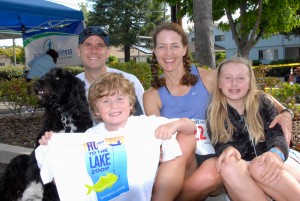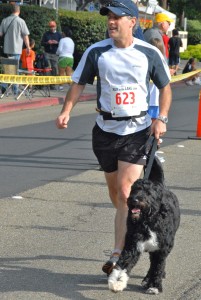Starting later this month, I will be blogging more regularly at our family’s new site, away-together.com. We leave in two weeks for nearly a full year of travel to several destinations, to educate our kids (and ourselves) by seeing other parts of the world and to strengthen our bond as a family. I’m excited, nervous and asking myself, How did August get here? Running in July mirrored the pace of my life. I’m relating a few highlights here to try to make sense of it all:
July 12: I stand at the start of a hilly 10K by Lake Chabot, seeing some road racing regulars for the first time in a long time. Morgan and the kids are with me to do the 5K. Coach Alphonzo is there with hugs and telling me to do the damn thing. I haven’t trained to race this distance on pavement in over a year — which is partly why I’m here: To face the challenge of running fast. To have fun (what a concept!) going all out. So I go for it, I go out fast with the lead women who turn out to be in the 5K. They peel off at the 5K turnaround and I’m the only woman near the front of the 10K pack (oh, sweet Jesus), trying to catch the guys ahead. We hit the hills by the lake and I’m on familiar territory. These hills put a PR way out of reach, but I’d like to finish close to 43 minutes. As we summit and turn around mile 4, I glimpse a pack of women about 30 seconds back. There’s one skinny fast one I recognize — I’ve raced with her off and on since the mid 1990s — but she’s always up ahead. I’m stronger on the uphills but she’ll get me going down. Everything hurts; this engine is in overdrive and burning up. I worry that I’m not a fast downhill runner. Then I recall Coach’s advice for the 10K: The race begins at mile 4. And I correct myself: I used to not be a fast downhill runner. Who says I can’t? I wipe the mental slate clean and pretend I’m starting a two-mile interval. I visualize the track and open up. In the distance on the final straightaway I recognize Morgan, Kyle and our dog jogging the end of the 5K.
I find a faster gear to pass them, and they’re so surprised — their shouts of encouragement push me from behind. The finishing chute is ahead with my daughter Colly on one side, screaming her head off — Go, Go! — and on the other side is Alphonzo, shouting You can do it! I am giving absolutely everything I have, everything. And suddenly some people scramble to stretch a finishing tape across the line a few yards ahead while the PA system broadcasts first female. I break the tape when the clock overhead reads 42:01.
July 25: I wander from our patio to the kitchen, drinking in the scene of friends at our goodbye-for-now party, and inwardly I fiddle with the lid on emotions that have been tamped down all summer.
My mouth is running on about running because of all the runners here, and it keeps going when I spot Len Goldman. It must be the Mendoza Malbec in me talking when I tell him about my 40th birthday morning, when I was cocky to think I could pull out a sub-6 mile and realized I would need to work for it. I wanna run a sub-6 mile before we go, I say. Meet me at the track, he says. We make a date because in a sloppy emotional state everything seems possible and worthwhile, and I forget about it. He sends me an email reminder the next day.
July 31: I run to the track feeling purpose mixed with dread, like the feeling I had so many years ago when I took the GRE after months of study. Len is there with a tape measure and orange cone. He stands on the field, by the line on the track where we normally start and stop, and he measures out 9.3 meters, a little over 30 feet. He explains that four laps are 1600 meters, but a true mile is 1609. He puts the orange cone where the finish to the mile will be, and then we warm up. Am I setting myself up to succeed, or to fail? I want to run an 800 fast to get ready so I do it in 3:03. Double it and see why it wasn’t a confidence builder. I’ll really have to work this, I tell him. Follow me, he says. We’ll keep each lap at 1:28. I line up behind him, countdown and go, and suddenly I’m fully focused on the white shirt on his back, watching his shoulder blades swing under the fabric, and all I care about is not letting any extra inch of space open between us. We hit 400 in 1:28, 800 in 2:56, and I feel I have something extra to give. I pass him in the third lap and hit 1200 in 4:22 and sprint as hard as I can to that orange cone, finishing the mile in 5:49.
This morning: I treat myself to a relaxed solo run/hike along a favorite stretch from the Steam Trains to Inspiration Point in Tilden Park above Berkeley, the fog so thick that the trees drip as if it’s raining. From Inspiration Point, I run on the Nimitz Trail for a mile and a half and then drop down to the Tilden Nature Center. The eucalyptus groves, these redwoods, this beautiful bowl-shaped canyon of the watershed tucked behind Berkeley — it’s brimming with nostalgia, for this is where I began running as a graduate student fifteen years ago, and this was my extended back yard when we had our first house up the hill in Kensington.
I impulsively take a sharp left to visit the Little Farm’s red barn one last time. (Why “one last time?” I’ll come back sometime, won’t I?) I used to come here weekly when the kids were toddlers. Approaching the brown cow, I reach out to stroke her wet nose and picture Colly’s chubby baby hand doing the same thing ten years ago. I mentally converse with the cow: Blossom? Clover? I’m sorry I can’t remember your name. For three years I kept lettuce in the fridge for you so we could feed you everytime we came. Why can’t I remember your name? Why am I standing here talking to a cow? Why do I still fancy that I can talk to animals like Tia in “Escape from Witch Mountain”? My shoulders shake a bit from a giggle bordering on hysteria. Then a brown-and-white speckled cow in the next stall over (Buttercup, is that you?) turns away from me and I notice strands of bloody tissue hanging from under her tail. What the heck? … I move closer to the other cow and see she is bending down to nuzzle a wobbly white calf that can’t be more than a day old. And that’s when I lose it — I start sobbing, grateful that no one but the cows and sheep can see me as I lean against the wood fence and let all the tears out. I can’t explain why I’m crying except that I know it’s cathartic and has to do with recognizing a turning point in life — a time when one phase comes to an end and a new one opens.
I leave the farm slowly and give myself time to think about what our family is doing — packing up our home and traveling for a year — and what transpired in the past month. Why did I need to go all out at that race and at the mile? I think I craved the boost of confidence and sense of control that comes with running my best at a time when everything is changing and we’re moving into unfamiliar territory. But I also wanted to gauge where I’m at in terms of speed and strength because I inevitably will slow down and soften in the year ahead. I’ll transition to a different way of running, which will mirror our different, more family-focused way of life. Serious running is inherently self-centered, and I know I run best when I’m selfish about it. I measure the miles, take time for the gym, step on the scale and such. That all will change, at least for the year — which is not a bad thing. I’ll be in strange places and more cautious for my safety, so I won’t run very far solo. I’ll be more flexible about what and how much I eat, and I won’t have a scale to step on. Perhaps best of all, when I run, I’ll run as a tourist — eyes wide open, often with camera in hand, stopping or slowing to capture the moments.
As if to douse my maudline mood, I feel my backside soaked with water and realize my hydration pack has sprung a leak. It’s more refreshing than irritating — a splash of cold water on feelings and an impetus to get moving.



You and your family are in for an amazing journey and I’m very impressed with your bravery.
The life/work balance is quite a challenge these days.
Your realization that the “stuff” was starting to perhaps get in the way of your life’s journey… that’s a solid.
Travel mandates that you simplify your life to essentials.
I think those essentials are something many people lose sight of as they move through life.
Having just lost a friend to an 8 year battle with cancer whose children are my children’s ages (mid and late 20’s) I was struck by a comment the officiating priest made at her memorial.
“We all die, but many of us never live.”
Congratulations and bon voyage.